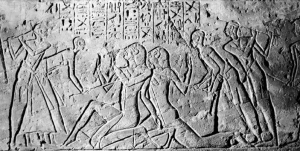Scholar Amar Annus has linked the name Sheth/Seth, found in the prophecy of Balaam recorded in Numbers 24:17, to an infamous Amorite tribe well known in the ancient Near East, the Suteans.
He notes that the Egyptian term for the Suteans, Šwtw, a form of the Akkadian Shutu, appears in one of the Execration Texts from the nineteenth or eighteenth centuries BC, about the time of Abraham, Isaac, and Jacob.
The Ruler of Shutu, Ayyabum, and all the retainers who are with him; the Ruler of Shutu, Kushar, and all the retainers who are with him; the Ruler of Shutu, Zabulanu, and all the retainers who are with him.[1]
The Execration Texts were like ancient Egyptian voodoo dolls. The names of enemies were inscribed on pottery, which were ritually cursed and then smashed. In a nutshell, “Sheth,” “Shutu,” and “Sutean” are the same name processed through different languages and types of writing.[2] Other Egyptian texts place the Shutu/Sheth in the central and northern Transjordan, which, significantly, includes Bashan—Rephaim territory.[3]
Other fascinating tidbits from the Execration Texts: The Shutu leaders were listed just after the “Rulers of Iy-‘anaq”—the Anakim tribes that Joshua and the Israelites would fight for control of Canaan about four hundred years later. Also, the Shutu leader named Ayyabum bears the same name as the biblical Job. Now, this was probably not the Job of the Old Testament, but the Egyptian curse does locate him in the Transjordan, the same general area that was home to the long-suffering Job[4] and exactly where the Bible places the Rephaim tribes. And, because you’ve read your Old Testament, you’ve noticed that the other Shutu leader, Zabulanu, has a name that Jacob would later give to one of his sons, Zebulon.
Here’s the key link: Annus points to an Akkadian lexical list (that’s like an ancient clay tablet version of Google Translate) that specifically equates ti-id-nu and su-tu-u—Tidanu and Sutean.[5]
Citing Michael Heltzer’s 1981 book The Suteans, Annus continues:
In Ugaritic literature Suteans are mentioned in the epic of Aqhatu, where the antagonist of the mt rpi Dnil [“man of the Rephaim, Daniel”] is a nomadic Ytpn, mhr št—“warrior of the Sutû, Sutean warrior.” …In the epic of Keret Suteans are mentioned as dtn, spelled also as ddn, and it “must be understood as the Di/Tidânu tribe, a part of common Amorite stock. It is even likely that this term was used in Mesopotamia at the end of the 3rd millennium to designate tribes later known as Suteans.”[6]
Highlight that! The Ugaritic Epic of Keret, which dates to the time of the Judges in Israel, connects the Amorite Sutean tribe, the sons of Sheth from Balaam’s prophecy, with the Ditanu—from which the Greeks got the name of their old gods, the Titans![7]
Here’s one more bit of historical evidence for your consideration: The Shutu are also identified in later Egyptian texts as the Shasu,[8] probably as language and pronunciation changed over the centuries. About two hundred years after the Exodus, Ramesses II (“the Great”) fought an epic battle against the Hittites at Qadesh, a city on the Orontes River near the modern border between Syria and Lebanon. According to the Egyptian account of the battle, Ramesses encountered a pair of Shasu nomads who told him the Hittites were about 125 miles away, near Aleppo, because the Hittite king, Muwatalli II, was “(too much) afraid of Pharaoh…to come south.”[9]

Turned out that was a lie. The Shasu had been sent by the Hittites to fool the Egyptians into relaxing their guard, a ruse that was discovered when a member of Ramesses’ bodyguard arrived with two Shasu prisoners who admitted that the full Hittite army was…well, right over there.[10]
Only quick thinking and what was apparently incredible personal bravery by the pharaoh prevented the Battle of Qadesh from becoming Ramesses’ Last Stand. The point is this: A surviving inscription commemorating the battle shows two Shasu prisoners, possibly the two who confessed to Ramesses, taking a beating from Egyptian soldiers. Here’s the thing: The Shasu spies are nearly as tall on their knees as their captors standing over them.
We can’t emphasize this enough: This is not typical of art of the ancient world. Normally, defeated enemies were depicted as much smaller than the “good guys.” Even 3,500 years ago, governments understood the power of propaganda. Yet, the Shasu captives were depicted as more than a head taller than the Egyptians soldiers around them.
This tracks with another Egyptian text that mentions the extraordinary height of the Shasu. A letter from an Egyptian scribe named Hori to another named Amenemope describes a mountain pass near Megiddo as “infested with Shasu.” According to Hori the scribe, “some of them are of four cubits or of five cubits, from head to foot.”[11] Since the Egyptian royal cubit was a little over twenty and one-half inches, that makes those Shasu between 6’8” and 8’6”. Bear in mind that was when average Egyptian men stood between 5’2”[12] and 5’6”.[13]
In other words, Egyptian evidence documents a nomadic people called the Shasu or Shutu, the Bible’s sons of Sheth, who scholars identify as an Amorite tribe called the Suteans. They lived in the Transjordan from the time of Abraham through the time of the Judges (roughly 1900–1200 BC). That was Rephaim territory. These people, like the Rephaim, were exceptionally big—two and a half to three feet taller than most Egyptians.
As the Israelites prepared to invade Canaan, the prophet Balaam foresaw a messianic figure, “a star,” who would come out of Jacob to “break down all the sons of Sheth.” These were the Suteans, Amorite nomads living in Rephaim country east of the Jordan. The Suteans were known in former days throughout Mesopotamia as the Ditanu/Didanu or Tidanu, dead kings of old who were linked to the Rephaim in ritual texts at Ugarit.
And, according to Amar Annus, the Dit/Did/Tidanu tribe was where the Greeks got the name of their old gods, the Titans.
Here’s the short equation:
Sheth = Shutu/Shasu = Suteans = Ditanu/Tidanu = Titans
In other words, the sons of Sheth were the sons of the Titans—the Rephaim, the spirits of the Nephilim.
Let’s complete the picture. Because “the Spirit of God came upon him,” we’ll take Balaam seriously: The pagan prophet foresaw not just the conquest of the nomads living in the Syrian desert, but the Messiah’s ultimate destruction of the sons of the Titans.
Whoa! Greek myth overlapping Bible prophecy? You bet.
And we’re just getting started.
[1] James B. Pritchard, Ancient Near Eastern Texts: Relating to the Old Testament (Ann Arbor, MI: Pro Quest, 2005), p. 329.
[2] Ibid.
[3] Amar Annus, “Are There Greek Rephaim? On the Etymology of Greek Meropes and Titanes.” Ugarit-Forschungen31 (1999), p. 18.
[4] Most Bible commentaries place the land of Uz in the Transjordan, usually near Edom.
[5] Annus, op. cit., p. 19.
[6] Michael Heltzer & Shoshana Arbeli-Raveh, The Suteans (Naples: Istituto Universitario Orientale, 1981). Cited in Annus, op. cit., p. 19.
[7] Annus, op. cit., p. 20.
[8] “Biblical Archaeology: Evidence of the Exodus from Egypt.” Institute for Biblical and Scientific Studies. https://www.bibleandscience.com/archaeology/exodus.htm, retrieved 3/3/18.
[9] John A. Wilson, “The Texts of the Battle of Kadesh,” The American Journal of Semitic Languages and LiteraturesVol. 34, no. 4 (1927), p. 278.
[10] Ibid.
[11] Rob Sullivan, “Egyptian War Correspondents and the Biblical Giants,” Associates for Biblical Research, Feb. 27, 2015 (https://biblearchaeology.org/research/conquest-of-canaan/3819-egyptian-war-correspondents-and-the-biblical-giants, retrieved 8/6/19).
[12] Alaa Shahine, “Ancient Egyptians Did It Tough.” ABC Science, March 31, 2008 (http://www.abc.net.au/science/articles/2008/03/31/2203404.htm, retrieved 3/3/18).
[13] Misha Ewen, “How Tall Were Ancient Egyptians?” Researchers in Museums, Jan. 21, 2015 (https://blogs.ucl.ac.uk/researchers-in-museums/2015/01/21/question-of-the-week-how-tall-were-ancient-egyptians/, retrieved 3/3/18).


